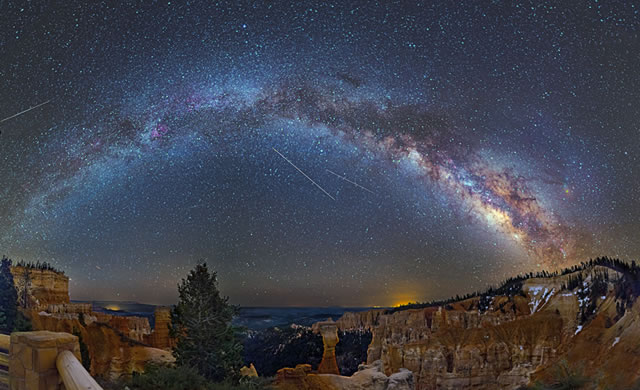
Image Credit & Copyright: Dave Lane
Il capo responsabile dell’ufficio della NASA impegnato sullo studio di ambiente e meteore, il Dr. Bill Cooke, spesso lascia che le telecamere inquadrino e osservino il cielo al suo posto. Lui e i suoi colleghi operano all’interno di una rete nazionale di osservatori automatici di meteore che catturano tutto ciò che brucia nell’atmosfera terrestre. La mattina del prossimo 24 maggio, però, ha in programma di vedere di persona. “Potrebbe verificarsi una nuova pioggia di meteoriti e voglio vedere con i miei occhi”, spiega Cooke.
L’evento previsto per questo mese di maggio riguarda le Camelopardalids, provocate dalle polveri della cometa periodica 209P/LINEAR. Nessuno le ha mai viste prima, ma quest’anno le Camelopardalids potrebbero allestire uno spettacolo celeste degno delle ben più famose Perseidi di agosto. “Alcuni meteorologi hanno previsto più di 200 meteore all’ora”, spiega Cooke. La Cometa 209P/LINEAR è stata scoperta nel febbraio del 2004 dal progetto Near-Earth Asteroid Research Lincoln, uno sforzo di cooperazione della NASA con il Massachusetts Institute of Technology Lincoln Laboratory, e la US Air Force. Si tratta di una cometa relativamente debole che si immerge all’interno dell’orbita della Terra una volta ogni cinque anni, in quanto gira attorno al sole. Due anni fa, gli esperti di meteoriti, il filandese Esko Lyytinen e Peter Jenniskens del NASA Ames Research Center, hanno annunciato che la Terra avrebbe avuto un incontro con i detriti dalla cometa 209P/LINEAR. Flussi di polvere espulsi dalla cometa principalmente nel 1800 starebbero per attraversare l’orbita terrestre il 24 maggio 2014. Il risultato, fanno sapere , potrebbe essere un importante sciame di meteore. Altri esperti, in parte, sono della stessa idea. Vi è un ampio consenso tra gli addetti ai lavori rispetto alla possibilità che la Terra possa essere interessata al passaggio attraverso i flussi dei detriti il 24 maggio. Tuttavia, nessuno è sicuro di quanti detriti si stia parlando. Tutto dipende da quanto attiva fosse la cometa più di un secolo fa, quando i flussi di detriti furono generati. Restate sintonizzati su www.denebofficial.com per tutti gli aggiornamenti del caso!
The head of NASA’s Meteoroid Environment Office, Dr. Bill Cooke, often lets cameras do his sky watching for him. He and his colleagues operate a nationwide network of automated fireball observatories that capture anything that burns into Earth’s atmosphere. On the morning of May 24th, however, he plans to go out in person. “There could be a new meteor shower, and I want to see it with my own eyes,” says Cooke.
The shower is the May Camelopardalids, caused by dust from periodic comet 209P/LINEAR. No one has ever seen it before, but this year the Camelopardalids could put on a display that rivals the well-known Perseids of August. “Some forecasters have predicted more than 200 meteors per hour,” says Cooke. Comet 209P/LINEAR was discovered in February 2004 by the Lincoln Near-Earth Asteroid Research project, a cooperative effort of NASA, the Massachusetts Institute of Technology Lincoln Laboratory, and the US Air Force. It is a relatively dim comet that dips inside the orbit of Earth once every five years as it loops around the sun. Two years ago, meteor experts Esko Lyytinen of Finland and Peter Jenniskens at NASA Ames Research Center announced that Earth was due for an encounter with debris from Comet 209P/LINEAR. Streams of dust ejected by the comet mainly back in the 1800s would cross Earth’s orbit on May 24, 2014. The result, they said, could be a significant meteor outburst. Other experts agreed, in part. There is a broad consensus among forecasters that Earth will indeed pass through the debris streams on May 24th. However, no one is sure how much debris is waiting. It all depends on how active the comet was more a century ago when the debris streams were laid down.
Source/Continue reading → NASA.gov
Stay tuned for more updates on www.denebofficial.com!





















